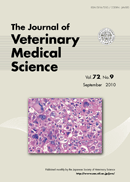Volume 72, Issue 9
September
Displaying 1-26 of 26 articles from this issue
- |<
- <
- 1
- >
- >|
Review
-
Article type: Virology
2010Volume 72Issue 9 Pages 1099-1106
Published: 2010
Released on J-STAGE: October 01, 2010
Advance online publication: April 16, 2010Download PDF (634K)
Anatomy
-
Lectin Histochemical Detection of Special Sugars on the Mucosal Surfaces of the Rat Alimentary TractArticle type: FULL PAPER
2010Volume 72Issue 9 Pages 1119-1127
Published: 2010
Released on J-STAGE: October 01, 2010
Advance online publication: April 07, 2010Download PDF (1183K) -
Article type: FULL PAPER
2010Volume 72Issue 9 Pages 1137-1143
Published: 2010
Released on J-STAGE: October 01, 2010
Advance online publication: April 13, 2010Download PDF (1302K) -
Article type: FULL PAPER
2010Volume 72Issue 9 Pages 1153-1158
Published: 2010
Released on J-STAGE: October 01, 2010
Advance online publication: April 16, 2010Download PDF (941K) -
Article type: FULL PAPER
2010Volume 72Issue 9 Pages 1159-1163
Published: 2010
Released on J-STAGE: October 01, 2010
Advance online publication: April 20, 2010Download PDF (776K)
Bacteriology
-
Article type: NOTE
2010Volume 72Issue 9 Pages 1251-1255
Published: 2010
Released on J-STAGE: October 01, 2010
Advance online publication: April 28, 2010Download PDF (738K)
Immunology
-
Article type: FULL PAPER
2010Volume 72Issue 9 Pages 1145-1151
Published: 2010
Released on J-STAGE: October 01, 2010
Advance online publication: April 16, 2010Download PDF (629K) -
Article type: FULL PAPER
2010Volume 72Issue 9 Pages 1195-1202
Published: 2010
Released on J-STAGE: October 01, 2010
Advance online publication: April 28, 2010Download PDF (643K)
Internal Medicine
-
Article type: FULL PAPER
2010Volume 72Issue 9 Pages 1113-1118
Published: 2010
Released on J-STAGE: October 01, 2010
Advance online publication: April 07, 2010Download PDF (614K) -
Article type: FULL PAPER
2010Volume 72Issue 9 Pages 1129-1136
Published: 2010
Released on J-STAGE: October 01, 2010
Advance online publication: April 13, 2010Download PDF (646K) -
Article type: FULL PAPER
2010Volume 72Issue 9 Pages 1165-1172
Published: 2010
Released on J-STAGE: October 01, 2010
Advance online publication: April 22, 2010Download PDF (777K) -
Article type: NOTE
2010Volume 72Issue 9 Pages 1203-1208
Published: 2010
Released on J-STAGE: October 01, 2010
Advance online publication: April 07, 2010Download PDF (652K) -
Article type: NOTE
2010Volume 72Issue 9 Pages 1209-1211
Published: 2010
Released on J-STAGE: October 01, 2010
Advance online publication: April 07, 2010Download PDF (833K) -
Article type: NOTE
2010Volume 72Issue 9 Pages 1221-1224
Published: 2010
Released on J-STAGE: October 01, 2010
Advance online publication: April 16, 2010Download PDF (587K)
Laboratory Animal Science
-
Article type: NOTE
2010Volume 72Issue 9 Pages 1243-1245
Published: 2010
Released on J-STAGE: October 01, 2010
Advance online publication: April 27, 2010Download PDF (505K)
Pathology
-
Article type: NOTE
2010Volume 72Issue 9 Pages 1213-1216
Published: 2010
Released on J-STAGE: October 01, 2010
Advance online publication: April 07, 2010Download PDF (796K) -
Article type: NOTE
2010Volume 72Issue 9 Pages 1225-1227
Published: 2010
Released on J-STAGE: October 01, 2010
Advance online publication: April 16, 2010Download PDF (624K) -
Article type: NOTE
2010Volume 72Issue 9 Pages 1233-1235
Published: 2010
Released on J-STAGE: October 01, 2010
Advance online publication: April 22, 2010Download PDF (752K)
Physiology
-
Article type: FULL PAPER
2010Volume 72Issue 9 Pages 1173-1177
Published: 2010
Released on J-STAGE: October 01, 2010
Advance online publication: April 23, 2010Download PDF (745K)
Surgery
-
Article type: FULL PAPER
2010Volume 72Issue 9 Pages 1107-1111
Published: 2010
Released on J-STAGE: October 01, 2010
Advance online publication: April 07, 2010Download PDF (625K) -
Article type: NOTE
2010Volume 72Issue 9 Pages 1229-1232
Published: 2010
Released on J-STAGE: October 01, 2010
Advance online publication: April 21, 2010Download PDF (835K)
Toxicology
-
Article type: NOTE
2010Volume 72Issue 9 Pages 1237-1241
Published: 2010
Released on J-STAGE: October 01, 2010
Advance online publication: April 24, 2010Download PDF (686K)
Virology
-
Article type: FULL PAPER
2010Volume 72Issue 9 Pages 1179-1187
Published: 2010
Released on J-STAGE: October 01, 2010
Advance online publication: April 24, 2010Download PDF (727K) -
Article type: FULL PAPER
2010Volume 72Issue 9 Pages 1189-1194
Published: 2010
Released on J-STAGE: October 01, 2010
Advance online publication: April 27, 2010Download PDF (634K) -
Article type: NOTE
2010Volume 72Issue 9 Pages 1217-1219
Published: 2010
Released on J-STAGE: October 01, 2010
Advance online publication: April 13, 2010Download PDF (616K) -
Article type: NOTE
2010Volume 72Issue 9 Pages 1247-1250
Published: 2010
Released on J-STAGE: October 01, 2010
Advance online publication: April 28, 2010Download PDF (500K)
- |<
- <
- 1
- >
- >|
